In case you didn't know, I drink a fair amount of coffee, and although I've been known to drink other coffee, the majority of my coffee comes from my local coffee roaster: Petaluma Coffee and Tea. Since I commonly forget to reuse my coffee bags, I tend to collect a pile of empty coffee bags and need to do something with them.
Showing off the Goods
To make a long story shirt, the process goes like this:
- collect a bunch of empty coffee bags
- remove the Petaluma Coffee logo
- use clear packaging take to stick those chickens where they are needed
- pedal around town being hella cool
Keep Rollin
Bad Craftsmanship and a Terrible Design
My crappy bicycle seat bag had a zipper that stopped closing properly and would pop open on occasion. I blame the terrible design of the bag that puts far too much stress on the zipper. What I found most distasteful about the failing zipper is that I made the bag. To be fair, the bag did work well for two years and it survived at least one hooligan attack. Hopefully, the next bag will last longer...
Time to retire those shorts
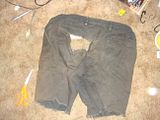 A long ago, I turned my favorite biking pants into a cap and a pair of shorts, and last Fall, those favorite shorts were retired to the scrap fabric pile after tearing in a non-duct-tape-repairable way. bummer.
A long ago, I turned my favorite biking pants into a cap and a pair of shorts, and last Fall, those favorite shorts were retired to the scrap fabric pile after tearing in a non-duct-tape-repairable way. bummer.
Hack and Sew
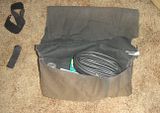 My plan was to be able to put my biking needs in the bag, roll the bag up tight, and then affix the bag to my bike. After hurting my thumb trying to cut the shorts with some degenerate right-handed scissors, I found some decent scissors and hacked the shorts into a usable bit of fabric which was then sewn into the form of a pocket with a very large flap.
My plan was to be able to put my biking needs in the bag, roll the bag up tight, and then affix the bag to my bike. After hurting my thumb trying to cut the shorts with some degenerate right-handed scissors, I found some decent scissors and hacked the shorts into a usable bit of fabric which was then sewn into the form of a pocket with a very large flap.
At this time, I had no idea how I was going to keep the bag closed or how I was going to attach the bag to my bike. So I relaxed and did some other crap for the rest of the evening.
Velcro!
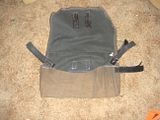 After having my morning coffee, I stitched some velco to the inside of the flap as well as the outside/back of the pocket in order to keep the damn thing closed. More velcro was sewn to side of the pocket and to the base of the flap so that I could have some loopy-doos to keep the bag connected to my bikey.
After having my morning coffee, I stitched some velco to the inside of the flap as well as the outside/back of the pocket in order to keep the damn thing closed. More velcro was sewn to side of the pocket and to the base of the flap so that I could have some loopy-doos to keep the bag connected to my bikey.
Really?
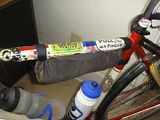 For some reason, when I went to put the bag on my bike, it attached quite easily with the velcro loopy-doos and I thought something must be wrong. Nope, it was all good. weird
For some reason, when I went to put the bag on my bike, it attached quite easily with the velcro loopy-doos and I thought something must be wrong. Nope, it was all good. weird
Inside of the bag:
- an adjustable wrench
- two patch kits
- two tire irons
- a pair of plastic chopsticks
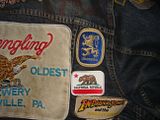 Since I had the sewing machine out, I figured i should throw that Löwenbräu and sweet California Republic patch on my patch jacket.
Since I had the sewing machine out, I figured i should throw that Löwenbräu and sweet California Republic patch on my patch jacket.
Testing the Bag
The best way to test the bag, at least in my opinion, is to take a ride to the beautiful Shollenberger Park, which is a 7 to 10 mile ride depending upon the route one takes. However, while trying to adjust my speedometer the other day, I accidentally reset the device, erasing my recorded miles. At the same time, I broke the adjusting button and the speedometer now records in kilometers. That's cool, the metric system is better anyway.
On my 16 kilometer trip, I saw various birds(including a White Tailed Kite) and two snakes. It had been about 3 years since I have seen a California Kingsnake and I unfortunately only managed to take a picture of it's tail as the snake slithered into a burrow on the side of the path. The other snake was a Gopher snake that was hogging the path. Get out of the way bub!
All things considered, I'd say the bag test was a complete success.
Now quit reading, and go recycle some old clothing
In the Northern Hemisphere where I live, it is now wintertime and due to limited daylight, I am riding more and more at "night". While I don't really mind the cold, I really really do not like when drivers on the road cut me off or pull out in front of me.
Perhaps they don't see me very well. I had better remedy that situation.
 For a few bucks at the local hardware store, I purchased a 2" x 24" strip of reflective tape. In order to make a little bit go a long way, the the tape was cut into 8 strips at ¼" x 24".
For a few bucks at the local hardware store, I purchased a 2" x 24" strip of reflective tape. In order to make a little bit go a long way, the the tape was cut into 8 strips at ¼" x 24".
Various lengths of the cut strips were then applied to various parts of my bicycle.
 This is the before shot of my bicycle after dark. The camera flash does a decent enough job of lighting up the bike for the human eye, but I want a bit more pizazz.
This is the before shot of my bicycle after dark. The camera flash does a decent enough job of lighting up the bike for the human eye, but I want a bit more pizazz.
Why is this such a bad picture? Fog. Taking flash pictures in fog tends to light up the water droplets in the air.
 Now that is what I'm talking about!
Now that is what I'm talking about!
Randomly placed strips on the bicycle rims will hopefully add a lot of visual noise when the bike is in motion.
Be seen.
only almost?
</jest>
This idea was inspired one evening when, riding 1.5 miles through town, I had three very close calls with drivers not paying attention.
There was one time that I drove my car to the car wash and maybe a car-pool or two with some friends, but for solo trips, it is walk or ride the bike, and all of the trips have been to a destination within 5 miles of my home ( that's 8 kilometers for my metric friends).
Many were the days towing groceries across town in the trailer, or pedaling to my favorite location of solitude along the river for some music practice.
At some point in the Spring of 2009, someone thought it would be a good idea to steal the speedometer off of my bicycle. Damn. Having grown accustomed to knowing how far I travelled when riding, I promptly purchased a new speedometer.
Today the new speedometer passed the thousand mile mark and I couldn't help but reminisce upon the various sights, sounds and people that made so many of my Summer bicycle trips so memorable. Thank you.
Now stop reading, and go ride to the store.
I found it very interesting that you chose a single speed bike. I had a look at Petaluma but couldn't really tell if you have much in the way of hills. About 3 months ago I started riding my bike to work, with a view to giving up my car. 7.5 - 8 miles each way depending on the route. But I'd be brave to use a single speed bike though. I travel from a hight of approx 130m to a low of 50m then up to 85m. Without doubt it is the gradient not much more than the actual hight that's a killer. (for an oldie like me anyway) Are you super fit or is Petaluma flat.
You may be interested in http://www.gmap-pedometer.com/ for determining distance and height of your routes.
I have two routes one to work where it's mostly down hill (just under 7.5 miles).
One back slightly longer (just over 7.5 miles) but longer. On this route as it does not drop to the lowest point. I hate having to go to the bottom of a hill, just to have to climb it.
Thanks
- pedaling
- steering
- balancing
- stopping
The most important of these principles is balancing and the least important is pedaling and with training wheels on a bike, a child only learns how to pedal ( and a few really bad habits).
It's all about balance. Without balance, a cyclist will fall over and won't have time to pedal, or steer, or stop. Unfortunately, when using training wheels, balance is never learned until after the training wheels are removed. If one learns balance first, everything elses will be a lot easier to learn.
Steering isn't learned when using training wheels? That's right. turning a bicycle left and right, especially at higher speeds, requires a cyclist to lean into turns. Since training wheels prohibit leaning over, a child will not learn how to properly navigate a bicycle.
Stop! The bike was moving and now it is not. What is the first thing a new rider should do? Put their feet on the ground. Because training wheels prohibit a bike from leaning over, one doesn't learn the importance of putting their feet on the ground when a bike is stopped and instead learns the bad habit of keeping their feet on the pedals.
A dandy horse doesn't need training wheels; teach the dandy horse method.
By removing training wheels from a bike, a new rider will need to learn to use their own legs to keep from falling over and at the same time they will learn how to balance on a bike. For propulsion, the child can simply run while seated on a bike. I shouldn't have to say it, but I will for safety sake: avoid hills when teaching a child to ride in this manner.
Happy Riding.
Anyway, I need some help I think.
Agree with all the above re training wheels - but unfortunately my daughter has them! In brief, she's 3 but fairly tall and certainly very physical and able... (she zips about at pace with good lean steering on her mini-micro scooter since before age 2 etc)
Anyway, we were in the bike shop where I was thinking a balance bike, but she immediately showed interest instead in the pedal bike (with training wheels) and hopped on and rode it round the store, pedalling steering stopping and all...and from this the salesperson told us that we'd missed her window for the balance bike....and so proud as punch her dad there and then bought her the purple pedal bike...which she loves!
So, now thing is she loves riding it, even going quite fast but I am nervous as anything as she has had a fall going round a corner; I think probably she turned too sharply while upright and the bike fell over (outwards)...and I've seen a couple of more nearly falls when at speed she's taken a curve and I've seen some leans (inwards) where the bike looks like it nearly tripped itself over its training wheel!...
What am I to do... tell her to go slowly, especially in the turns? Or go back and purchase a balance bike and lay down the law insisting she use it instead? (of the nice purple one..) Or try and get the pedals off the purple one? (not even sure this is possible given the back-pedal braking set up there also?)...
I just don't know where to go with this now. Please help. I certainly don't want to cramp her natural ability to learn! What do I do?
(and sorry for not being so brief in the and after all).
take off the pedals
lower the seat until she can place both of her feet flat on the ground with her knees slightly bent.
There is no need to purchase anything
Happens someone has now lent us a FIrstBike...which she is enjoying playing on and coasting about a little even, so yes I reckon it won't be long at all until I move to what you recommend, and then in due course give her the pedals back:
btw any guidance on when to be sure that a child has reached the stage when they're ready for the pedals?...
an adjustable wrench
a spare tube
a patch kit
a spoke wrench
a tire pump
a pen
a lighter
a swiss army knife
a set of tire irons
a folder plastic bag
I should really get a small bike lock for the bag, as well as a some allen wrenches.
While riding my bicycle home from a friends house, I look down and saw that my right pant leg was not rolled up and I thought, "I should pull over and roll up my pant leg". Being three blocks from home, the pant leg rolling never took place, as I opted to just head home.
Can you guess where this is going?
Seconds later, I felt an extremely strong tug on my leg and heard a loud ripping sound in the vicinity of my right leg....... My pants, my favorite bike riding pants, my comfortable light pants, torn from ankle to knee were missing a large chunk of fabric that disappeared mysteriously. The damage was irreparable.
Looking on the bright side
A few months ago, a sewing machine that was destined for the thrift store, was diverted to my humble abode. Now, thanks to the sewing machine, my former favorite pants are my favorite shorts. But the fun doesn't stop there. After cutting of the pant legs to make shorts, I was left with some perfectly good black fabric. hmmmmm....
Thanks to a sewing pattern for a cycling cap, I now have a favorite cycling cap. Actually, it is a good all around cap, but the bill needs to be a bit wider. So without further ado, I present, "The Cap".
A friend gave me an old baby stroller that he no longer needed. With hacksaw in hand, I chopped up the aluminum frame into what I envisioned to be workable pieces. A few PVC pipe fittings and a few nuts and bolts later, I had a working frame. Sweet sweet duct tape made the platform of the trailer.
Done.
On to part 2:
And here is the trailer attached to "The Green Squeaker" and ready for action.
How oh how will I fix this damn thing?
It had dawned on me that since the housing was made of cheap plastic, it would be necessary to not just stick the pieces back together with some adhesive, but to also add some sort of structural support to keep the piece of crap from breaking again in the future. Standard epoxy would not be up to the task.
Thank you Caleb.
My late friend Caleb introduced me to JBweld in the mid-90s when I needed a way to fix a rather difficult problem: a cracked intake manifold on 68 Plymouth. Hot damn! JBweld is the stuff of legends. Caleb used to spin a yarn about repairing a cracked engine block with the gray goo of the gods. That sounds dirty.
So Sad. Wait... What? That isn't sad. That's an opportunity for some leather crafting! Here is a quick breakdown of the process I used to add some new leather to the saddle.
A leather punch and a pop-riveter attached the leather to frame quite well.
Cuir Bouilli, a process of using hot water to harden leather was used on my new saddle to really firm things up. A few coats of red stain later, I was ready to rock and roll. Shazaam!!





